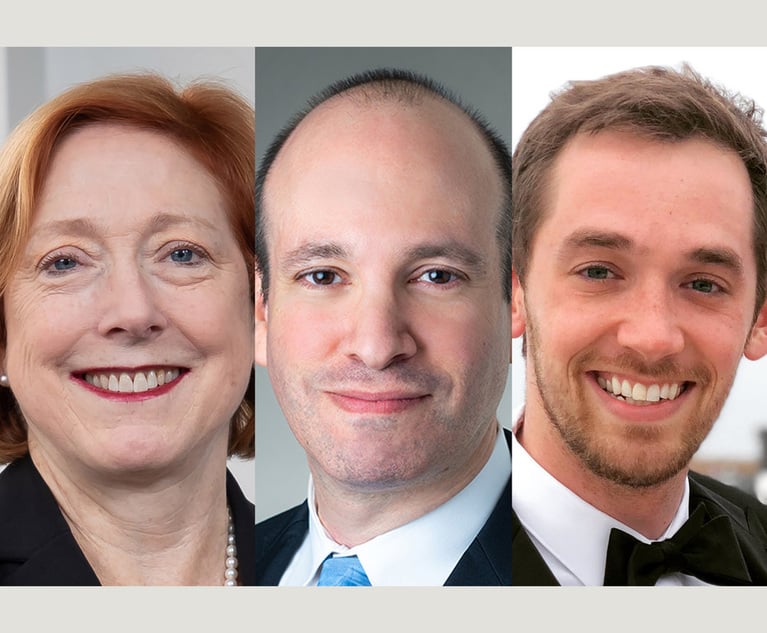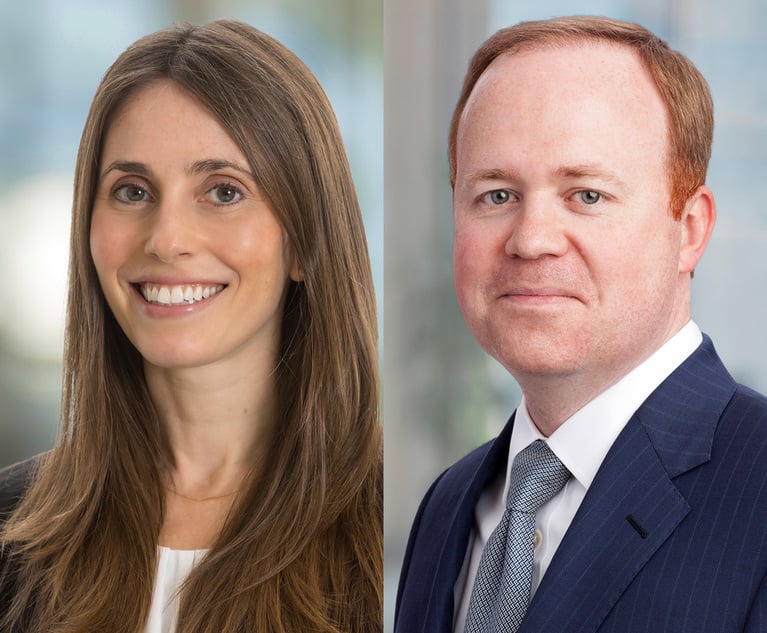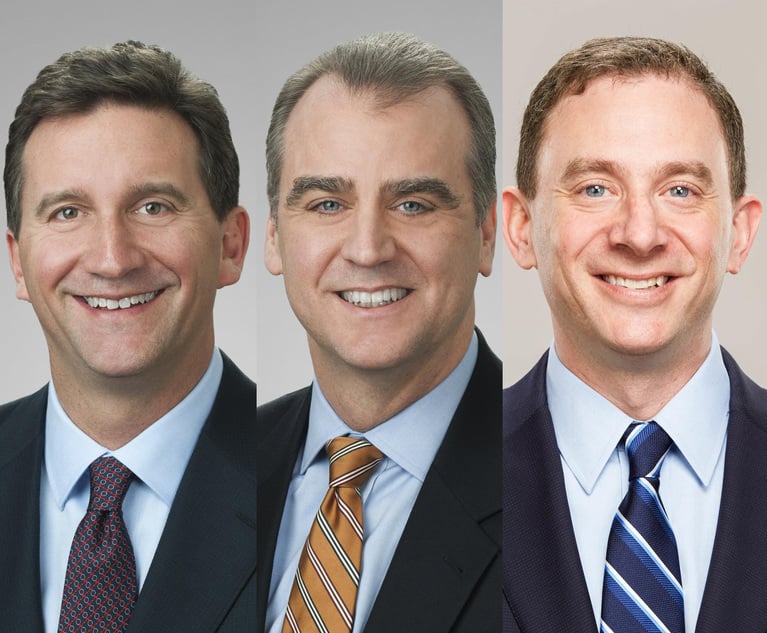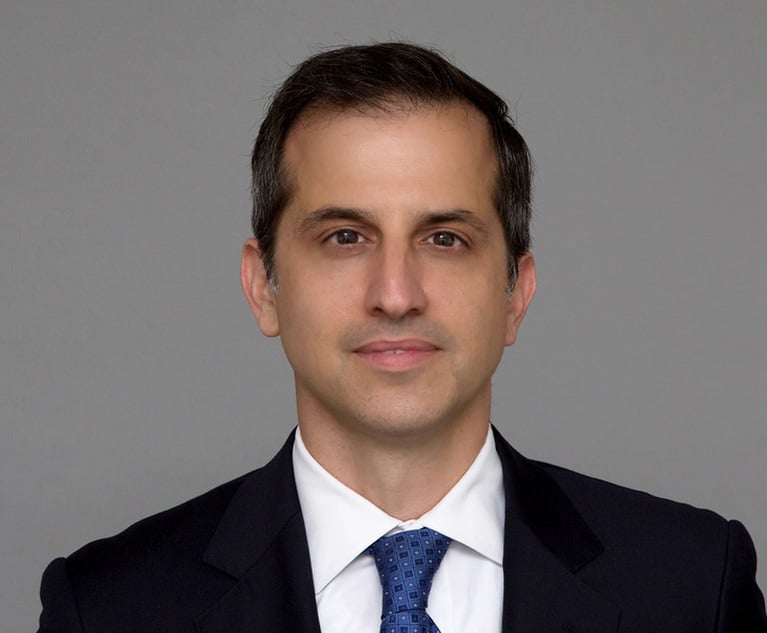Patent Assertion Entities Are Making a Comeback. Here's What Defendants Need to Know
Baker Botts partner Sarah Guske says it's critical to distinguish between the small players looking for a quick payout, and the big entities who've proven their staying power.
March 26, 2019 at 05:47 PM
10 minute read
The original version of this story was published on The Recorder
 Sarah Guske, Baker Botts partner. (Photo: Jason Doiy/ALM)
Sarah Guske, Baker Botts partner. (Photo: Jason Doiy/ALM)
Patent assertion entities seem so 2012. Businesses that acquire patents and then enforce them—sometimes criticized as “patent trolls”—have largely dropped out of the headlines since the America Invents Act (AIA) and the Supreme Court's Alice decision simplified the process of challenging patent validity in many cases.
But PAEs, as they're also known, haven't disappeared from the litigation radar altogether. Some have been attracting big new investment while others have reorganized and started reviving litigation campaigns. This comes as the Patent Trial and Appeal Board has become slightly less willing, statistically, to cancel patents in AIA proceedings, and the U.S. Court of Appeals for the Federal Circuit has added more gloss to the Alice v. CLS Bank International decision.
We caught up with Baker Botts IP partner Sarah Guske last week to take a quick check of where PAE litigation stands and the kinds of defensive steps companies targeted by them should consider. Guske will be moderating a discussion of the subject May 7 at IP Counsel Cafe's Palo Alto conference.
So PAEs are still a force to be reckoned with?
People were expecting the death of patent assertion entities when the AIA came in, and all of that. Some of those activities sorted themselves out, but the patent assertion entities live on.
And it feels like maybe starting to make a comeback?
Yes, I think so. I mean, you've got the Unilocs of the world that continue to file large campaigns, RealTime [Data LLC] and others, you see quite a bit of activity that keeps going. There might be some assertion entities that have been sitting on portfolios for a while, that have now been seemingly emboldened by shifting statistics at the PTAB, and differing treatment of Section 101 than what we've seen since Alice came out [due to] Berkheimer [v. HP] and Aatrix [Software v. Green Shades Software]. District courts have been slower to grant early 101 motions. So the pendulum is swinging back in the other direction and the activity is kicking up a little bit.
How have PAEs changed over the last five years?
It's more polarized into two camps than it used to be back in the heyday. You've got the big, well-funded, more sophisticated campaigns, and then on the other end, you've got the quicker-to-settle campaigns. But you don't have much of the middle anymore, where you might litigate for awhile, get through discovery and then settle. It's either something that settles before you get to an answer, or it's going to be something like Intellectual Ventures or Uniloc where they're going to fight for a long time.
Does that mean different strategies depending on which type you're dealing with?
I think so. There are some entities, they're kind of notorious, you know just by name what camp they're going to fall into. But you definitely do a quick bit of homework when you see a complaint or a letter come in [from less well-known entities], and you can get a pretty good feel right away based on how many times the patents have been asserted and how quickly they've gone away. Even something as simple as what counsel is representing them [might indicate] OK, you'll probably be able to work out a resolution quickly if that's what you want to do, as an accused infringer. Or OK, we're going to need to hunker down, this is something we're going to need to fight for a long period of time on.
Has anything changed in terms of the demand letters you see now versus what you saw five years ago? There've been congressional hearings, there's been state legislation, the PTO director just mentioned it as a potential problem earlier this month.
One of the bigger impacts on what kind of letter you're getting and whether the entity is going to be sending a letter is a byproduct of Halo [Electronics v. Pulse Electronics, the Supreme Court's 2016 decision on enhanced damages for willful infringement].
If you're a patent assertion entity that's going to go through the steps of sending out some sort of demand letter, to get yourself where you want to be [for enhanced damages], the letter's going to have be something more than “Hey, we've got this portfolio.” There's going to need to be some more detail.
It feels a little less boilerplate than it was for a period of time, where you'd get the assertion entity that would send out the same packet to everybody, it would list 40 patents, and then leave the recipient completely in the dark as to what was going to happen next or what their exposure was.
How else has the playing field changed?
I think [the Supreme Court venue decision] TC Heartland [v. Kraft Foods Group Brands] has changed the game quite a bit the last couple of years too. It's put patent assertion entities in a position where they're going to have to be a little bit more selective and strategic about how they file, because gone are the days you can file [multiple cases] simultaneously in Texas, for instance, and be pretty comfortable that you'll be there, your cases will be coordinated, you'll have the same judge ruling on pretrial motions and claim construction.
Now that's been broken up quite a bit, so patent assertion entities are either needing to stage their campaigns, and be careful that they don't get their cases into a jurisdiction where they might be more prone to get kicked out early on a 101 motion, which will then have impacts on cases pending in other venues.
On the defense side, you can sort of take advantage of that. If you've got a couple of clusters of cases that are in different courts, you might be able to leverage joint defense groups to strategize about who takes shots where, in certain courts.
So the PAEs have to choose a venue they're not likely to get transferred out of, because if they get transferred out they could wind up somewhere they really don't want to be.
That's right. So some patent assertion entities, what they'll do is maybe they'll stage a campaign where they pick a few targets where they feel pretty comfortable they can stay in the court where they want to stay, and maybe they'll work those cases through to a certain point, whether it's to fund subsequent litigation or get favorable precedent on claim construction, or an early 101 motion that might help them later on, even in a different court. They'll play that out before maybe moving on to the next round of targets.
You do get some bolder patent entities that say, OK, we're going to sue this group in ED-Texas, and two weeks later we're going to turn around and we're going to sue some more in the Western District of Texas, and then some more in the Central District of California. If you do get cases that are pending simultaneously in overlapping courts, you can try to get some rulings—a 101 motion is a good example. Some courts won't grant them early, some will.
Are you seeing a lot of cases filed in the Central District of California?
Even before TC Heartland it was a hot docket for patent cases, but I would say since TC Heartland I've seen quite a big increase in the Central District of California. A lot of that's a function of that's where the defendants actually have proper venue. It's a big region and a big court. I would also speculate that there might be a little bit of hope on patent assertion entities' part that the Central District is a little better for them than the Northern District. I don't know that that's actually statistically true. But I could see that being the logic.
What changes are you seeing in the bar that represents PAEs?
We're seeing firms that feel like they're almost specialists in the patent assertion area. You've got firms that are probably more experienced and well funded that are handling the bigger campaigns, and the campaigns that are more likely to go to trial. On the polar opposite end with the companies that are more prone to want to settle out early, you've got some really small firms that don't appear to have a ton of patent litigation experience.
You don't get the firms that do quite a bit of defense work in Big Law venturing into that space at all on the enforcement side. You get firms like Susman [Godfrey] and Russ August & Kabat and all those folks that appear quite a bit for the bigger enforcement entities.
Any tips you have for clients when they're encountering a PAE for the first time?
The best thing they can do at that point—and this isn't to promote outside law firms—but I think it makes sense to sit down with attorneys that have seen these before, and can help make the evaluation: OK, is this going to be the kind of suit that we need to look at opportunities for early resolution because that's going to be a possibility, or are we dealing with an assertion entity that has demonstrated a willingness to go the distance and fight and drag a lot of people through?
Yes, you're upset, you've been sued by a company you've never heard of, and are now going to have to deal with it and spend money. But is it the best business and defense strategy decision to go in guns blazing, and go to the PTAB, and file early motions, or does it make more sense to look at this as, “OK, we may not like it, but let's talk about what the better business resolution is versus spending money on people like me for a long period of time.”
Are there still many established companies that take the position that, “We're just not going to settle, regardless how little the cost, if we think the claim doesn't have merit?”
I think there are still some of those, but I think there probably has been a shift in the last 10 years to start thinking about OK, can we do this for every case we get threatened with or that gets filed? It's maybe not practical from an internal resource perspective and the time that it takes to do that. I think you've still got both, but I think some of the companies that were originally taking hard lines may have re-evaluated the hard stance in all scenarios and positions that they may have had 10 years ago.
This content has been archived. It is available through our partners, LexisNexis® and Bloomberg Law.
To view this content, please continue to their sites.
Not a Lexis Subscriber?
Subscribe Now
Not a Bloomberg Law Subscriber?
Subscribe Now
NOT FOR REPRINT
© 2025 ALM Global, LLC, All Rights Reserved. Request academic re-use from www.copyright.com. All other uses, submit a request to [email protected]. For more information visit Asset & Logo Licensing.
You Might Like
View All
Litigators of the Week: Shortly After Name Partner Kathleen Sullivan’s Retirement, Quinn Emanuel Scores Appellate Win for Vimeo

Litigators of the Week: A Knockout Blow to Latest FCC Net Neutrality Rules After ‘Loper Bright’

Litigators of the (Past) Week: Defending Against a $290M Claim and Scoring a $116M Win in Drug Patent Fight

Litigation Leaders: Jason Leckerman of Ballard Spahr on Growing the Department by a Third Via Merger with Lane Powell
Trending Stories
- 1Chief Judge Joins Panel Exploring Causes for Public's Eroding Faith in NY Legal System
- 2Pogo Stick Maker Wants Financing Company to Pay $20M After Bailing Out Client
- 3Goldman Sachs Secures Dismissal of Celebrity Manager's Lawsuit Over Failed Deal
- 4Trump Moves to Withdraw Applications to Halt Now-Completed Sentencing
- 5Trump's RTO Mandate May Have Some Gov't Lawyers Polishing Their Resumes
Who Got The Work
J. Brugh Lower of Gibbons has entered an appearance for industrial equipment supplier Devco Corporation in a pending trademark infringement lawsuit. The suit, accusing the defendant of selling knock-off Graco products, was filed Dec. 18 in New Jersey District Court by Rivkin Radler on behalf of Graco Inc. and Graco Minnesota. The case, assigned to U.S. District Judge Zahid N. Quraishi, is 3:24-cv-11294, Graco Inc. et al v. Devco Corporation.
Who Got The Work
Rebecca Maller-Stein and Kent A. Yalowitz of Arnold & Porter Kaye Scholer have entered their appearances for Hanaco Venture Capital and its executives, Lior Prosor and David Frankel, in a pending securities lawsuit. The action, filed on Dec. 24 in New York Southern District Court by Zell, Aron & Co. on behalf of Goldeneye Advisors, accuses the defendants of negligently and fraudulently managing the plaintiff's $1 million investment. The case, assigned to U.S. District Judge Vernon S. Broderick, is 1:24-cv-09918, Goldeneye Advisors, LLC v. Hanaco Venture Capital, Ltd. et al.
Who Got The Work
Attorneys from A&O Shearman has stepped in as defense counsel for Toronto-Dominion Bank and other defendants in a pending securities class action. The suit, filed Dec. 11 in New York Southern District Court by Bleichmar Fonti & Auld, accuses the defendants of concealing the bank's 'pervasive' deficiencies in regards to its compliance with the Bank Secrecy Act and the quality of its anti-money laundering controls. The case, assigned to U.S. District Judge Arun Subramanian, is 1:24-cv-09445, Gonzalez v. The Toronto-Dominion Bank et al.
Who Got The Work
Crown Castle International, a Pennsylvania company providing shared communications infrastructure, has turned to Luke D. Wolf of Gordon Rees Scully Mansukhani to fend off a pending breach-of-contract lawsuit. The court action, filed Nov. 25 in Michigan Eastern District Court by Hooper Hathaway PC on behalf of The Town Residences LLC, accuses Crown Castle of failing to transfer approximately $30,000 in utility payments from T-Mobile in breach of a roof-top lease and assignment agreement. The case, assigned to U.S. District Judge Susan K. Declercq, is 2:24-cv-13131, The Town Residences LLC v. T-Mobile US, Inc. et al.
Who Got The Work
Wilfred P. Coronato and Daniel M. Schwartz of McCarter & English have stepped in as defense counsel to Electrolux Home Products Inc. in a pending product liability lawsuit. The court action, filed Nov. 26 in New York Eastern District Court by Poulos Lopiccolo PC and Nagel Rice LLP on behalf of David Stern, alleges that the defendant's refrigerators’ drawers and shelving repeatedly break and fall apart within months after purchase. The case, assigned to U.S. District Judge Joan M. Azrack, is 2:24-cv-08204, Stern v. Electrolux Home Products, Inc.
Featured Firms
Law Offices of Gary Martin Hays & Associates, P.C.
(470) 294-1674
Law Offices of Mark E. Salomone
(857) 444-6468
Smith & Hassler
(713) 739-1250






